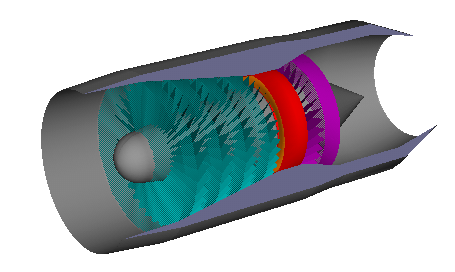|
 What is propulsion? The word is derived from two Latin words:
pro meaning before or forwards and pellere
meaning to drive. Propulsion means to push forward
or drive an object forward. A propulsion system is a machine
that produces thrust to push an
object forward. On airplanes, thrust is usually generated
through some application of Newton's third
law of action and reaction. A gas, or working fluid,
is accelerated by the engine, and the reaction to this acceleration
produces a force on the engine.
What is propulsion? The word is derived from two Latin words:
pro meaning before or forwards and pellere
meaning to drive. Propulsion means to push forward
or drive an object forward. A propulsion system is a machine
that produces thrust to push an
object forward. On airplanes, thrust is usually generated
through some application of Newton's third
law of action and reaction. A gas, or working fluid,
is accelerated by the engine, and the reaction to this acceleration
produces a force on the engine.
A general derivation of the thrust
equation shows that the amount of thrust generated depends
on the mass flow through the engine and the exit velocity
of the gas. Different propulsion systems generate thrust in
slightly different ways. We will discuss four principal propulsion
systems: the propeller, the turbine
(or jet) engine, the ramjet,
and the rocket.
Why are there different types of engines?
If we think about Newton's first law
of motion, we realize that an airplane propulsion system must
serve two purposes. First, the thrust from the propulsion
system must balance the drag of
the airplane when the airplane is cruising. And second, the
thrust from the propulsion system must exceed
the drag of the airplane for the airplane to accelerate. In
fact, the greater the difference between the thrust and the
drag, called the excess thrust,
the faster the airplane will accelerate.
Some aircraft, like airliners and cargo planes,
spend most of their life in a cruise condition. For these
airplanes, excess thrust is not as important as high engine
efficiency and low fuel usage. Since
thrust depends on both the amount of gas moved and the velocity,
we can generate high thrust by accelerating a large mass of
gas by a small amount, or by accelerating a small mass of
gas by a large amount. Because of the aerodynamic efficiency
of propellers and fans,
it is more fuel efficient to accelerate a large mass by a
small amount. That is why we find high bypass fans and turboprops
on cargo planes and airliners.
Some aircraft, like fighter planes or experimental
high speed aircraft, require very high excess thrust to accelerate
quickly and to overcome the high drag associated with high
speeds. For these airplanes, engine efficiency is not as important
as very high thrust. Military aircraft typically employ afterburning
turbojets. Future hypersonic aircraft will employ some
type of ramjet or rocket
propulsion.
The site was prepared at NASA Glenn by the
Learning Technologies Project (LTP) to provide background
information on basic propulsion for secondary math
and science teachers. The pages were originally prepared
as teaching aids to support EngineSim, an interactive
educational computer program that allows students to design
and test jet engines on a personal computer. Other slides
were prepared to support LTP videoconferencing workshops (http://www.grc.nasa.gov/WWW/K-12/CoE/Coemain.html)
for teachers and students. EngineSim is currently available
as a JAVA applet which runs in your
browser. The program can also be downloaded
to your machine.
We have intentionally organized this site
to mirror the unstructured nature of the world wide web. There
are many pages here connected to
one another through hyperlinks. You can then navigate through
the links based on your own interest and inquiry. However,
if you prefer a more structured approach, you can also take
one of our Guided Tours through the
site. Each tour provides a sequence of pages dealing with
some aspect of propulsion.
NOTICE --- The site has recently been modified
to support Section 508 of the Rehabilitation Act. Many of
the pages contain mathematical equations which have been produced
graphically and which are too long or complex to provide in
an "ALT" tag. For these pages, we have retained the (non-compliant)
graphical page and have provided a separate (compliant) text
only page which contains all of the information of the original
page. The two pages are connected through hyperlinks.
- Beginner's Guide
to Aerodynamics
- Beginner's Guide to Propulsion
- Beginner's Guide
to Model Rockets
- Beginner's Guide
to Kites
- Beginner's Guide
to Aeronautics
   
Back to top
Go to...
- Beginner's Guide
Home Page
byTom
Benson
Please send suggestions/corrections to: benson@grc.nasa.gov
|
